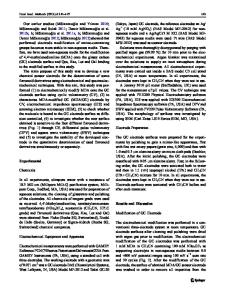Application of ZnO/CNTs Nanocomposite Ionic Liquid Paste Electrode as a Sensitive Voltammetric Sensor for Determination
- PDF / 429,467 Bytes
- 9 Pages / 595.276 x 790.866 pts Page_size
- 49 Downloads / 364 Views
Application of ZnO/CNTs Nanocomposite Ionic Liquid Paste Electrode as a Sensitive Voltammetric Sensor for Determination of Ascorbic Acid in Food Samples Majede Bijad & Hassan Karimi-Maleh & Mohammad A. Khalilzadeh
Received: 25 November 2012 / Accepted: 18 February 2013 # Springer Science+Business Media New York 2013
Abstract In this study, a simple and rapid analytical method development for ascorbic acid (AA) determination in food samples by using differential pulse voltammetry (DPV) method on ZnO/CNTs nanocomposite ionic liquid modified carbon paste electrode. For this, several parameters, such as ZnO/CNTs nanocomposite, ionic liquid ratio, and pH, have been studied. The cyclic voltammogram showed an irreversible oxidation peak at 0.61 V (vs. Ag/AgClsat), which corresponded to the oxidation of AA. Compared to common carbon paste electrode, the electrochemical response was greatly improved. Under the optimized conditions, the oxidation peak current of AA showed linear dynamic range 0.1–450 μmol l−1 with a detection limit of 0.07 μmol l−1, using the DPV method. The proposed sensor was successfully applied to the determination of AA in fresh vegetable juice, fruit juices and food supplement samples without previous preparation and was compared with a published electrochemical method. Keywords Food sample analysis . Ascorbic acid . Voltammetry . Ionic liquid . ZnO/CNTs nanocomposite
M. Bijad Department of Food Science, Science and Research Branch, Islamic Azad University, Mazandaran, Iran H. Karimi-Maleh (*) Department of Chemistry, Graduate University of Advanced Technology, Kerman, Iran e-mail: [email protected] M. A. Khalilzadeh Department of Chemistry, Science and Research Branch, Islamic Azad University, Mazandaran, Iran
Introduction Ascorbic acid (AA), as a water soluble vitamin, is an effective reducing agent and a powerful antioxidant in food, preventing color changes and alterations of aroma and flavor as well as extending the storage time of the products (Yu and Chen 1997). Although AA is naturally present in a wide range of foods, particularly fruits and vegetables, it has limited stability and may be lost from foods during storage, preparation and cooking. In some foods, it is purposely added to attract consumers and to act as an antioxidant to prolong the shelf life of the commercial product (YebraBiurrun 2000). Rapid monitoring of AA levels during production and quality control stages is an important step in food and pharmaceutical industrial applications (Yu and Chen 1997). Owing to the wide use of AA, many analytical techniques such as chromatography (Lykkesfeldt 2000; Ross 1994; Dennison et al. 1981; Sood et al. 1976), spectrophotometry (Guclu et al. 2005; Tabata and Morita 1997; Besada 1987), mass spectrometry (Conley et al. 2008), flow injection (Grudpan et al. 1999; Alwarthan 1993), chemiluminescence and electrochemical methods (Agater and Jewsbury 1997; Lin et al. 2011; Nalini and Narayanan 2000; Wu et al. 2000; Ensafi et al. 2012; Asnaashariisfahani et al. 2012; Beitollahi et al. 2009
Data Loading...











